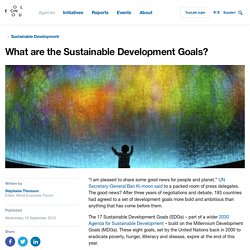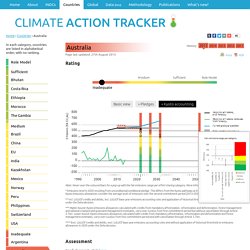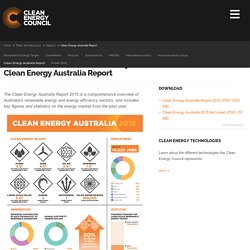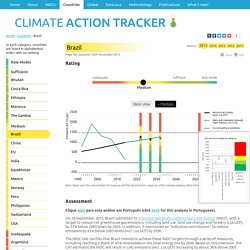Sdg7_olms
SDG7 OLMS
Sustainable Development Goals: 17 Goals to Transform Our World. What are the Sustainable Development Goals?
“I am pleased to share some good news for people and planet,” UN Secretary-General Ban Ki-moon said to a packed room of press delegates.

The good news? After three years of negotiations and debate, 193 countries had agreed to a set of development goals more bold and ambitious than anything that has come before them.
Delivering on commitments. Global Advocacy: Gender-Focused Community-led Development for All. The purpose of this note is to provide a brief outline the similarities and differences between the Millennium Development Goals (MDGs) launched in 2000, and the Sustainable Development Goals (SDGs), to be launched in 2015 when the MDGs expire. (Update 4 December 2014)The Secretary-General has released his Synthesis Report on SDGs, which affirms and strengthens the 17 goals described below).
This note must be somewhat speculative, since the governments will not finalize their agreement on the SDGs until September 2015 at the earliest. However, for the past two years, the general “shape” of the SDGs has remained surprisingly stable. There are certain key similarities.
Theconversation. Much as we should remain sceptical of politicians proclaiming themselves to be decisive, no-nonsense actors on climate change, the previous prime minister, Tony Abbott, did plenty more than talk.

He and his government channelled their lack of political will to address the climate problem into an enthusiastic appetite for “direct action” going well beyond the predictable abolition of the so-called “carbon tax”.
About ARENA - Australian Renewable Energy Agency. ARENA is the Australian Renewable Energy Agency, a commercially oriented agency.

It was established on 1 July 2012 by the Australian Renewable Energy Agency Act 2011. We have two objectives:
Goal 7: Affordable and clean energy. Australia - Climate Action Tracker. Page last updated: 27th August 2015 Print Rating Basic view+ Pledges+ Kyoto accounting Assessment For full report, click here.

On 11 August 2015, Australia submitted its Intended Nationally Determined Contribution (INDC). All other industrial countries, except Canada and New Zealand, have proposed 2025 or 2030 goals significantly below 1990 levels. Australia is one of five industrialised countries rated “inadequate” by the Climate Action Tracker (the other four are Canada, Japan, New Zealand and Russia). Australia has a large gap between policies and targets. Making renewable energy more affordable - RN Breakfast. How to make Australia's clean energy transition fair for all - One Step Off The Grid. It’s no secret that with well over one million solar households, decentralised energy solutions like rooftop solar have started to change the Australian market significantly.

Communities have embraced clean energy and the genie cannot be put back into the bottle. Indeed, the introduction of low-cost solar PV, battery storage, energy control and management systems and energy efficiency measures provide an unprecedented opportunity for energy consumers to participate in the energy system. However, it is crucial to ensure that all Australians are able to participate and benefit from the transition to renewable energy.
Certainly, solar PV is not just for the wealthy, as some political commentators would have us believe. But, while lower- and middle-income households have embraced solar, Australia’s lowest income houses have been least able to access solar PV to date.
Goal 7: Affordable & Clean Energy. Clean Energy Council - Clean Energy Australia Report. The Clean Energy Australia Report 2015 is a comprehensive overview of Australia's renewable energy and energy efficiency sectors, and includes key figures and statistics on the energy market from the past year.

The Clean Energy Australia Report 2015 includes a comprehensive round-up of renewable energy projects, investment, employment and electricity generation. It is the only analysis that includes the National Electricity Market, the Western Australian electricity grid and other major regional grids across the country in areas such as the Northern Territory. The main findings from the report are as follows: Renewable energy provided 14.6 per cent of Australia’s electricity in 2015, enough to provide power for the equivalent of approximately 6.7 million average homes.
Brazil - Climate Action Tracker. Page last updated: 26th November 2015 Print Rating Basic view+ Pledges Assessment Clique aqui para esta análise em Português (click here for this analysis in Portuguese).

On 28 September 2015, Brazil submitted its Intended Nationally Determined Contribution (INDC), with a target to reduce net greenhouse gas emissions, including land use, land use change and forestry (LULUCF), by 37% below 2005 levels by 2025.
Renewable Energy 2015: Australia vs. the World - Solaray Energy. Australia ranks 20th on progress towards the Sustainable Development Goals. Australia may be home to some of the world’s most liveable cities, but we have a long way to go to meet the world’s Sustainable Development Goals (SDGs).

Australia ranks 20th in the world – well behind Canada and many European countries but ahead of the United States – according to a new index that compares different nations' performance on the SDGs, which were adopted last September. Launched at this week’s United Nations SDG talks in New York, the index marks each country’s performance towards the 17 goals. These aim to put the world on a more sustainable economic, social and environmental path, and feature 169 targets to be met over the next 15 years in areas such as health, economic growth and climate action.
IRENA RE Latin America Policies 2015 Country Brazil. Chapter 3: The role of the Renewable Energy Target. This chapter considers the role of the Renewable Energy Target (RET) in the current policy context, including the introduction of the carbon pricing mechanism and the establishment of the Australian Renewable Energy Agency (ARENA) and the Clean Energy Finance Corporation (CEFC).

This chapter explores the way these policies interact with the RET and their implications for the future role of the RET. Finally, the appropriate frequency of reviews of the RET is considered. 3.1.
Clean Energy Australia Report 2014. Chapter 3: The role of the Renewable Energy Target. The Center for Health and the Global Environment. Climate change, primarily attributed to a rise in greenhouse gases produced by burning fossil fuels, strikes at the pillars of what keeps us healthy: adequate food, safe and sufficient fresh water, clean air, and freedom from infectious diseases that may intensify in the wake of natural catastrophes.

In the coming decade, business and policy decisions about where and how we derive our energy will affect our lives for the next century and beyond. The Center’s Climate, Energy, and Health program strives to bring the best possible science about what is at stake for our health into these decisions. Our energy is our health Energy provides life-sustaining and health-promoting goods, from the electricity that powers much in our lives, to the fuel that transports us from one place to another. But not all energy is equal when it comes to what it means for our health. Among these hazards are extreme weather events related to climate change. Displaced populations A sustainable economy. About the Renewable Energy Target. To power our homes and businesses, Australia generates electricity from coal and gas fired power stations, as well as a range of renewable energy sources including large-scale hydropower facilities and wind farms, and small-scale solar hot water and solar rooftop panels.
The Renewable Energy Target is an Australian Government scheme designed to reduce emissions of greenhouse gases in the electricity sector and encourage the additional generation of electricity from sustainable and renewable sources. The Renewable Energy Target works by allowing both large-scale power stations and the owners of small-scale systems to create certificates for every megawatt hour of power they generate.
Confidence in renewable energy sector 'evaporated' after Abbott cut: Bloomberg. Power sector emissions jump Investment in large-scale renewable energy in Australia remains stagnant almost two years after the Abbott government began a review of the sector, according to an annual survey by Bloomberg New Energy Finance. Loaded: 0% Progress: 0% How will solar batteries change the household? Reunion island volcano erupts NASA intern: 'It's out of this world'
The SDGs - It’s about people, not targets.
Take a look at the satellite photograph of the Indonesian archipelago at night accompanying this blog. Does knowing that Indonesia experiences significant levels of energy inequality require complex data sets run against an endless series of baseline measures and indicators, when it’s so clearly captured in a single image? That was one question Dr Yanuar Nugroho, from the President of Indonesia’s Executive Office, asked at a recent Research for Development Impact (RDI) Network forum on the Sustainable Development Goals (SDGs). Dr Negroho is working hard to see the SDG agenda aligned with his Government’s national development priorities.
What motivates him? People – not goals, he said.
Theconversation. On September 25 world leaders will meet in New York to formalise the new Sustainable Development Goals. These 17 goals will guide efforts to reduce poverty and increase well-being, without destroying the Earth. The Conversation is looking at how we got here, and how far we have to go. Unlike the Millennium Development Goals (or MDGs) that applied only to developing countries, the Sustainable Development Goals (or SDGs) will apply to all countries, including Australia. The new goals will have a key goal of eradicating extreme poverty, but they also have a much wider agenda. While the MDGs achieved considerable success in reducing poverty in developing countries, key challenges of climate change, environmental degradation, rising inequality and conflict present a significant risk to the well-being of all of us, including Australians.
SDSN Solutions Initiative “Sustainable Cities”: SDG Localization in Brazil.
Urban challenges are broadening in scope and require concerted policies and implementation strategies that extend beyond local boundaries.
Brazil announces massive reforestation and renewable energy plan with US. Barack Obama and Dilma Rousseff put climate change at the top of their agenda at their bilateral meeting on Tuesday, with the US and Brazil agreeing to obtain up to 20% of their electricity from renewable power by 2030. Brazil also committed to restoring up to 12m hectares of forest – an area about the size of England or Pennsylvania – in another attempt to reduce the carbon pollution that causes climate change.
Why isn't Brazil exploiting its amazing wind capacity?
Brazil has made huge strides in divesting from fossil fuels. In 2009 the country produced a staggering 85% of its electricity from renewable resources.
Sustainable Development Goal on Energy (SDG7) and the World Bank Group.
Access to clean, modern, sustainable energy is critical for improving the health and livelihoods of billions of people around the world. There is growing evidence linking socioeconomic benefits with access to a reliable and affordable supply of electricity. For example, with adequate lighting and a reliable supply of electricity in the evening, children can read and do homework longer, families can listen to the radio, watch television, or generate income.
Sustainable Energy for All and SDG 7 in Focus. Brazil's Clean-Energy Boom Running Out of Steam. Brazil’s renewable energy industry is poised for a setback this year as the slumping economy dries up credit, curbs power demand and threatens new transmission lines needed to connect projects to the grid. Following years of growth that made Brazil the world’s 10th biggest wind market, the industry is revising down the amount of new capacity expected in 2016, along with the number of new wind projects expected to win contracts at government auctions. President Dilma Rousseff is facing issues including the Zika virus, an inflation rate that’s climbed to 10.8 percent and a local currency that’s down more 35 percent in the past year.
Untitled. Sao Paolo, Brazil -- There is an old joke that says Brazil is the country of the future – and always will be.
Renewable Energy in Brazil. Despite being the world’s tenth largest consumer of energy, Brazil is an example as to what can be achieved with clean, renewable energy sources on a global scale; it is a world leader in pioneering new biofuel technologies. Brazilian energy supplier Neoenergia was founded in 1997 and made its first investment in generation in 1999.
Untitled. By Rafael Figueiredo and Larry B. Pascal, Haynes and Boone, LLP (Texas)
Countdown day 11 – SDG 7: Affordable and Clean Energy. Goal 7. Brazil's Diverse Energy Matrix — SugarCane.org. History. Global Compact Network Australia.
United Nations sustainable development agenda. Sustainable Development Goals. Yarra Valley Water: Aurora Waste to Energy Project Gets Underway. Sustainable development goals: all you need to know. Implementing SDG 7. Sustainable Development Goals an overview. How can we store more energy from the sun and the wind?
SDGs. Energy - United Nations Sustainable Development.








